We’re here to help. Contact our team at [email protected] to connect with our language services experts.
Please contact us if you have any questions or want additional help with your Language Services RFP.
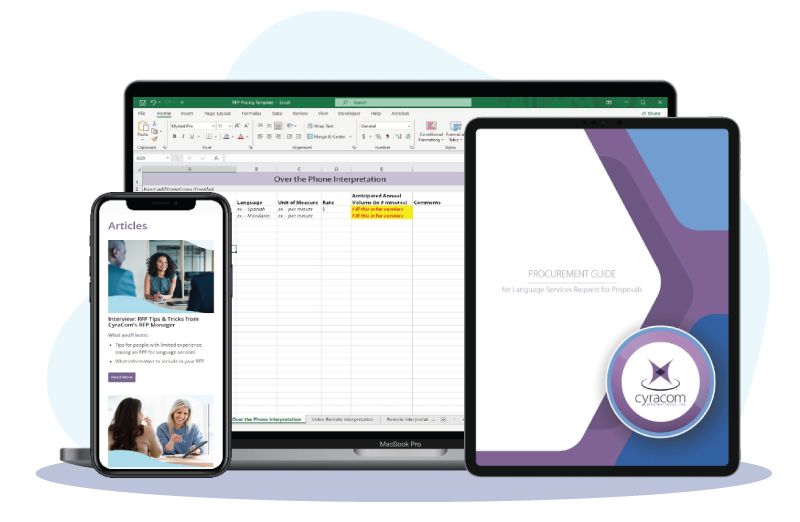
Download one of CyraCom’s helpful RFP Guides to learn what to look for in a Language Services Provider. Choose the guide that best fits your industry: Healthcare, 9-1-1, or Business. Each guide includes sample RFP questions about:
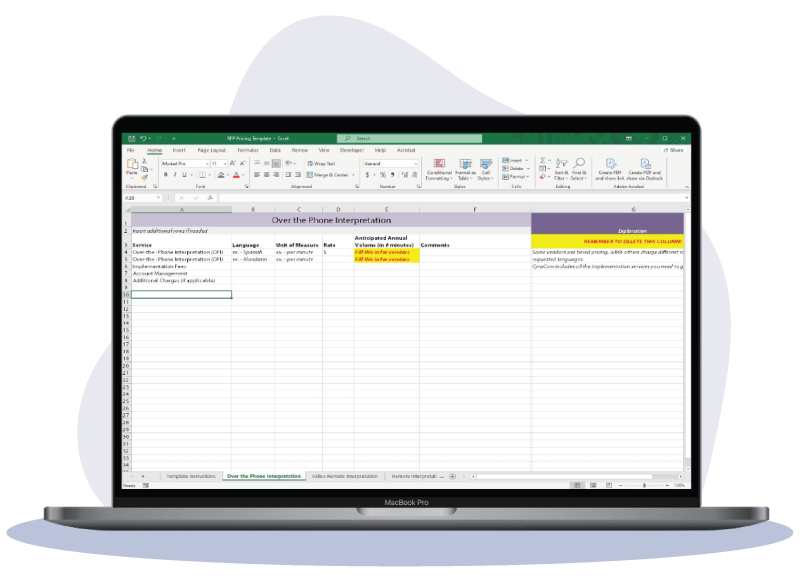
Download our RFP pricing template and customize it to fit your needs. The pre-formatted spreadsheet includes helpful instructions, notes, and explanations, as well as individual tabs for each language service you may require:
What you’ll learn:
What you’ll learn:
What you’ll learn:
What you’ll learn:
Article One
If your organization’s procurement team is writing a language services RFP (Request for Proposal), you want to create an RFP document and process that produces clear, concise responses from language service providers (LSPs).
Our RFP Manager, Nicole Coen, and her team have read, reviewed, and responded to hundreds of RFPs for interpretation and translation services. We interviewed her to hear her recommendations to make it easier for you and other evaluators to read and compare providers.

Thanks, I’m happy to help! One of the first things I’d recommend is researching language services terminology. Many RFPs refer to interpretation and translation as synonyms when they’re very different services, which can make it challenging to determine which services the needs.
We also see many requests for remote interpretation without specifications for phone, video, or options. The language services industry has changed significantly in the past few years, so it’s important to know about new services and vocabulary.
Finally, think about whether your pricing template matches language services industry norms. Most LSPs use per-minute pricing for interpretation and per-word pricing for translation. Make sure to include questions about fees, equipment purchase/rental pricing, and added value so you can better compare providers.
The timeline for the RFP process can significantly impact the quality of responses you receive. Having more time to craft our RFP response allows us to customize answers to your company’s needs and values.
If you allow LSPs to ask questions at least a week before the deadline, they can recalibrate answers with customized solutions and recommended services. Rushed changes leave more room for errors and lower-quality content.
Recommendation: Think about the RFP timeline from the responders’ point of view—did you allow enough time for them to deliver everything you asked for?
It’s always helpful to know:
For translation services RFPs, it’s super convenient when the client provides samples or detailed information about the project, especially for eLearning or video projects. Understanding exactly what you need helps us deliver accurate solutions and pricing.
Recommendation: Be specific about your needs wherever possible and set clear expectations. Tell responders what you care about most, and they’ll tailor their responses to meet that need.
Yes! We provide RFP guides to help craft questions and know what to look for in an LSP:
We’re currently creating new content for procurement teams, and offer many resources for healthcare and business organizations on our website. CyraCom’s blog has a ton of information about all aspects of language services. For anyone new to language services, I’d also recommend subscribing to our Language Access 101 course.
Contact our team at [email protected] for a free language services consultation.
Article Two
What’s the best way to receive comprehensive responses to your language services RFP? We’ve gathered tips and tricks to help you write and organize your Request for Proposal for optimal responses. Read on to learn how to improve your RFP document and get the best responses from language services providers (LSPs).

The structure of your Request for Proposal can significantly impact the quality and clarity of responses you receive. Your selection committee will need to read, analyze, and compare responses—provide clear guidelines that make it easier for readers to comprehend. Ask respondents to use a distinct labeling system for each section and question or provide an outline you’d like them to follow.
Separate questions about various services into different sections (and remember, interpretation and translation aren’t synonymous). For example, divide phone, video, on-site, and teleconferencing interpretation questions into individual sections, then separate your required translation services such as document translation, eLearning localization, and braille transcription.
Think about what’s most important to your organization and ask for that information first. For example, if you primarily need interpretation solutions but ask many questions about translation first, responders may misunderstand your goals.
Here are a few more tips:
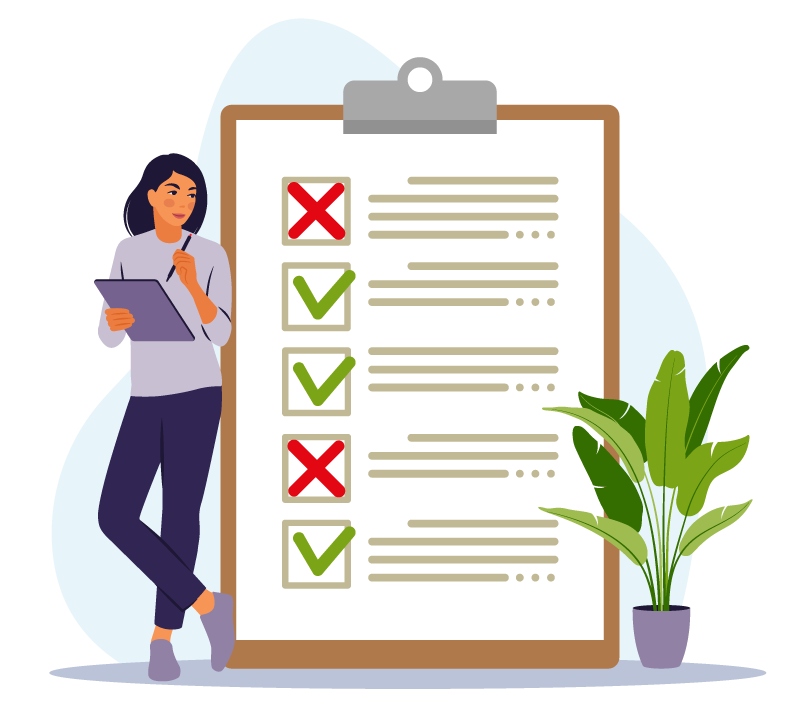

While most RFP respondents expect language with a formal, legal, or contractual tone for terms and conditions, it’s helpful when RFP documents are written using plain language. Simplify the language in your RFP wherever possible—instructions, company background, and supplemental information, for example.
Asking straightforward questions using uncomplicated language helps responders know exactly what information to provide about their language services. Confusing or overly wordy questions may confuse responders, meaning they may not deliver the information you need.
Check out our RFP Guides for more sample questions.
Want more language services information?
Subscribe to CyraCom’s blog or contact our team at [email protected] for a free language services consultation.
Article Three
Cost is often the most significant factor in choosing a language services provider. But how do you know you’re getting the best value for your investment? If your organization plans to issue an RFP for language services, review our tips and download our pricing template to help you compare vendors.
Make sure your language services RFP pricing template has the following elements:

Individual tabs for OPI, VRI, OSI, translation, and equipment can minimize confusion and highlight which vendors offer the most value for each service.

RFP pricing templates should allow vendors to showcase all aspects of their pricing model. Limiting rows may not give you the full picture of how your investment will be spent.

Many language services providers charge different rates for Spanish or American Sign Language (ASL) compared to other languages (LOTS). Translation services RFP pricing templates should allow for extra space or rows, as per-word pricing can greatly vary by language.

Allowing vendors to clarify, describe, or add context can provide a better understanding of their pricing model or any added value opportunities.

Some vendors may offer a “discounted” price for the first year of a contract, but make up for the loss in the following years. Asking for the total price of the contract can help your team evaluate the true investment without distracting gimmicks.

“Nickel and dime” fee charges add up over time. Your RFP pricing instructions should ask vendors for transparent pricing, including how you’ll be charged for account support, contacting an operator, or rushing a translation project.

If you need to print pricing information for your records, make sure your template fits on standard 8.5” × 11” We recommend using narrow margins and landscape orientation to allow space for additional/wider columns as needed.
Let’s review a few RFP pricing examples to see what works well and what could be improved.
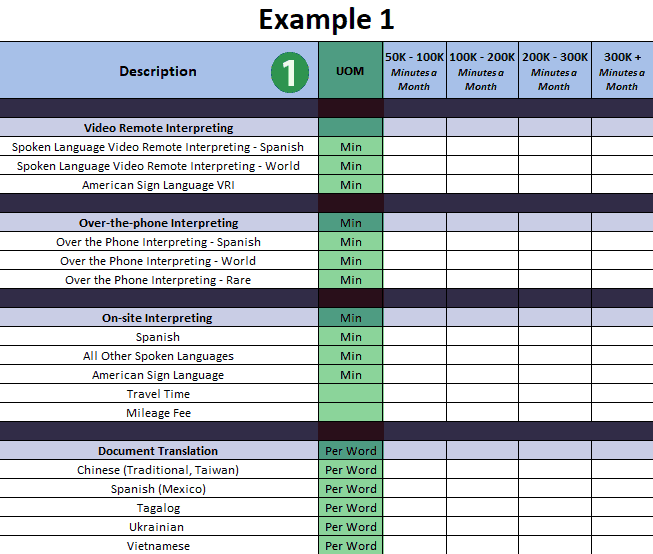
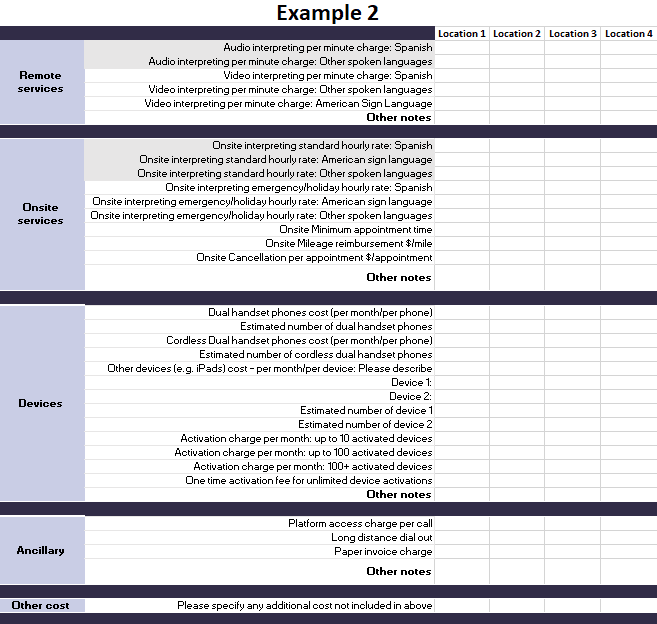
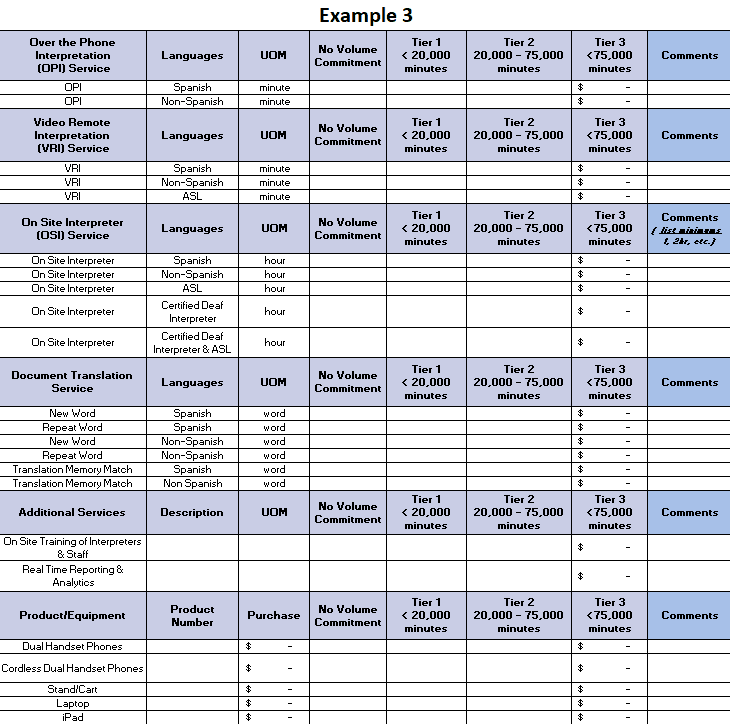
After reviewing dozens of RFP pricing examples, we’ve created a simple, easy-to-modify template for your next language services RFP. Our template includes instructions and explanations to help you customize the spreadsheet to meet your needs.
Article Four
Once you’ve learned how to write an RFP, sent it out into the world, and received responses, it’s time for your selection committee to review and evaluate potential partnerships. What criteria should you look for? How will you compare language services providers?
Here are four critical evaluation themes to consider:

Investing in high-quality language services helps ensure your customers, clients, or patients can effectively communicate with your staff. So how can you determine if a language services provider (LSP) will deliver the level of service you need? Check RFP responses for information about:
Using an LSP with consistent, trained, and culturally competent interpreters can help reduce risks and non-compliance. As you review vendor responses, consider:
You need a translation partner that exceeds industry standards and delivers accurate, culturally appropriate projects. Look for:
Qualified LSPs often hold accreditations from the International Organization for Standardization (ISO), including Quality Management System, Information Security Management, and Translation Services. Learn more about ISO accreditations here.
Beyond high-quality language services, you need an LSP that offers excellent customer service to your staff. While all companies promote robust support systems, compare these details in each RFP response:


Linguists regularly handle sensitive information. You need detailed information about the LSP’s security measures to protect your organization, patients, or customers from a data breach or HIPAA non-compliance. Verify each LSP’s ability to safeguard confidential information:
Language services pricing isn’t as simple as comparing the cost per minute—you need to know the value you’ll receive. Think about:

We’re here to help. Contact our team at [email protected] to connect with our language services experts.
About CyraCom
In business for over 25 years, CyraCom is a language services leader that provides interpretation and translation services to thousands of organizations across the US and worldwide.
Sales Inquiries
New Client Signup &
Current Client Support
CyraCom Careers
Corporate Office
2650 E Elvira Rd, Suite 132
Tucson, AZ 85756
Sign in to your account